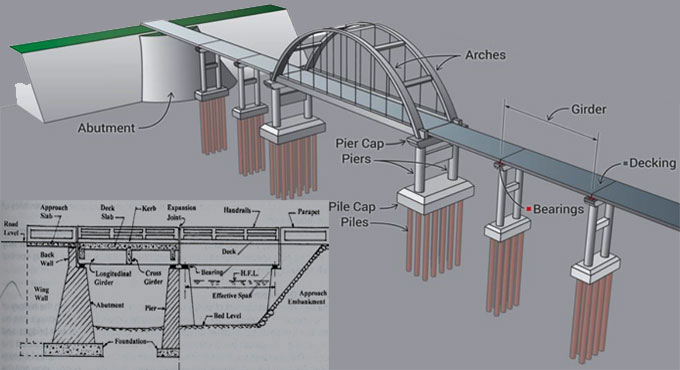NEWS | SOFTWARE | SHEET
Construction of bridge and its various components
In bridge construction, the entire basic goods and materials are organized in three parts substructure, foundation and superstructure.
Foundation: It keeps the deep or shallow foundation/base of the bridge and conveys its load to the bearing strata that contains foundations beneath the major magnitude/extent of the bridge and the abutments beneath initial positions of the bridge.
Substructure: Major parts are abutments, piers, caps, bearings, spandrels, and additional parts which keep the uppermost construction.
Superstructure: The entire parts of the bridge which are attached above the assisting substructure arrangement, it covers parts such as girders, slab, decking, and anything given above the main deck such as steel truss system, posts, cable-stayed system, cable suspended systems, bridge girder, etc.
Specified beneath, the information on major components of contemporary bridges:
Abutment: It refers to the terminal points/endpoints of the bridge. So as to bear intense lateral pressures, abutment is augmented.
Pile: It is also known as footing, pier, and beam. In pile system, reinforced concrete post is pressed within the base/ground to act like the leg or present assistance for the bridge. The space/span amid the piles is computed to provide assistance to the remaining structure that is going to be positioned above them.
Cap: Cap lies above the pile beam to provide additional support and allocate the load to the piles beneath. The combination of Cap and Pile constituents is called Bent.
Span or Girder: It stands for part of the major components of the bridge that joins the entire Piles beams. It consists of numerous simple spans, a single continuous span assisted through different beams, cantilever spans as well as cantilever spans possessing the suspended span amid them.
Girders are even utilized like a component of firm/rigid frame system wherein they’re completely joined with frame legs (which could be inclined or stay in V shape).
Superstructure truss system/network: Truss network that offers assistance/support to travel plane/surface, is constructed through 3 diverse methods such as Deck truss wherein traffic goes/passes above truss system/network, Pony truss wherein truss system/network goes/passes amid 2 analogous/parallel walls of trusses, and across/through truss that offers additional cross-supported/cross-braced truss system/network above and underneath the traffic.
Deck Beam: Simple continuous decks are made from reinforced or metal concrete. They consist of sub-components such as expansion joint, approach slab, drainage scupper, curb, footpath, running surface.
Barriers: Parts/sides of the bridge decks generally include additional barrier components such as handrails, ground fixtures, and railings.
Arch: Archways/Arches on the bridges are described through the quantity of hinges comprised (generally amid 0 or 3) which determine what extent of load and stress they may securely carry/bear, and the sort of materials utilized for construction (truss arrangement/system, solid material). Arches beneath the bridge are called trussed deck arch or spandrel-braced (cantilever).
Spandrel: Spandrels refer to the nearly triangular distance amid the main column/pillar of the bridge and decking. Furthermore, stone bridges utilize packed ‘sealed’ spandrels deck arches; while contemporary bridges made-up of metal utilize open spandrel deck arch arrangements/configurations.
Truss: Structure/framework is built through combining the triangles and additional structures which allocate stress forces and load above its whole structure. Moreover, they’re usually categorized into different sorts such as covered bridge truss, simple truss, Whipple truss, Pratt truss, Warren truss changes, Fink truss, Howe truss, suspension truss arches as well as numerous Cantilever truss changes.


